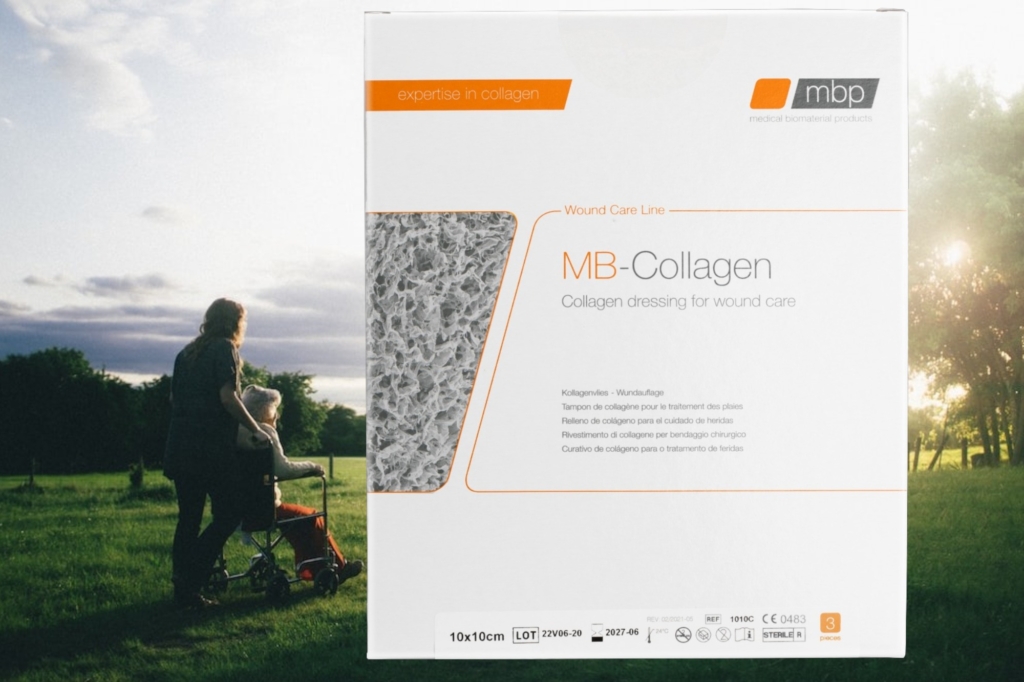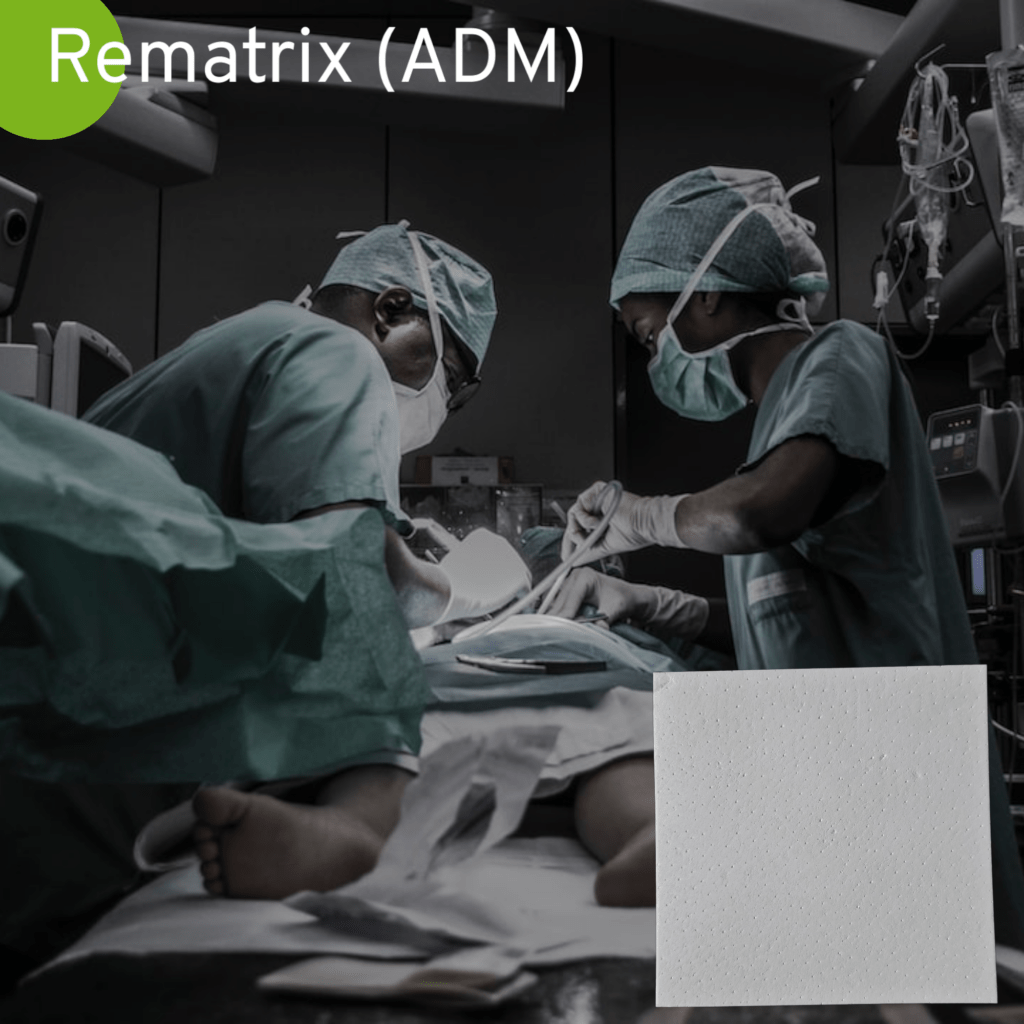Haemostasis
Haemostyptics from pure collagen
The MBP products Surgicoll and Diacoll Collagen as a haemostyptic agent
Topical haemostyptics form a modern standard for the treatment of e.g. oozing haemorrhages. These haemostyptics are characterised above all by their efficiency. Collagens are among the most efficient topical haemostyptics and offer a possibility for sustainable wound care thanks to their excellent tissue compatibility and rapid absorption.
The functioning of haemostyptics made from collagen is based on different mechanisms:
- Promote blood clotting: Collagen is able to activate platelets. Platelets are small cells in the blood that reach the wound site when the blood vessel is injured and interact with each other and the surrounding tissue to stop the bleeding.
- Formation of a clot: By activating platelets and interacting with the surrounding tissue, collagen promotes the formation of a temporary clot. This clot closes the wound and thus stops the bleeding.
- Promoting wound healing: Collagen also has positive effects on the healing process. It is an important building block for the formation of new tissue, as it promotes the migration of cells responsible for the repair and regeneration of the injured tissue.
- Biological absorption: Collagen haemostyptics are absorbed by the body over time. This happens through the body’s own enzymes, which break down the collagen into smaller molecules and then metabolise them.
- Reduced operation time compared to oxidised regenerated cellulose

Topical hemostyptic from porcine collagen, e.g. after vascular punctures
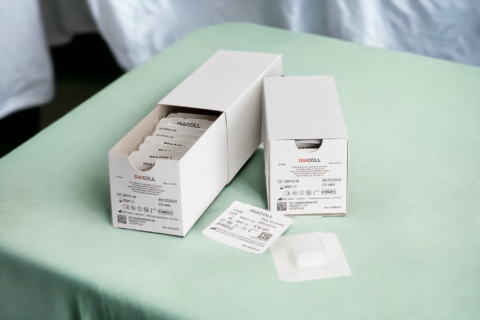
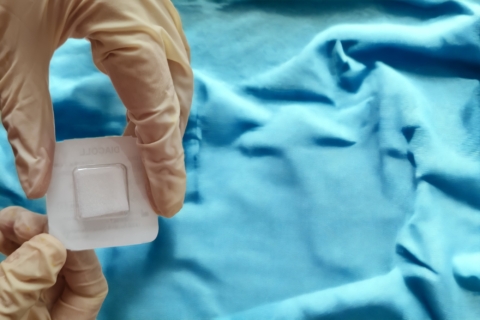
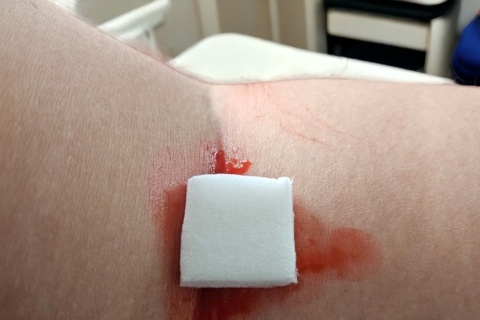
Diacoll
Topical collagen wound dressing for fast and efficient hemostasis. Diacoll is an effective hemostatic wound dressing made of fully absorbable collagen.
The collagen matrix initiates fast, reliable and sustainable blood clotting. Due to its easy handling, Diacoll supports efficient hemostatic wound care of the patient, e.g. after dialysis. Shortened treatment times enable a higher patient throughput.
The spongy collagen scaffold ensures rapid and reliable blood clotting via two complementary mechanisms. While the swelling properties of the collagen scaffold lead to the concentration of platelets and thus to accelerated clot formation, the chemical and topological properties of the collagen fibrils trigger the release of blood clotting factors with the aggregation of platelets, which activate the coagulation cascade.
Properties
- highly effective, local hemostyptic for wound care after vascular puncture, e.g. after dialysis
- Shortens the time to wound closure and reduces the risk of wound infection
- easy and fast handling
- Adheres to the surface and is easily removable
Practical application description
After opening the sterile packaging, Diacoll is removed with sterile, dry instruments and applied to the largely cleaned wound surface with suitable aids (e.g. swabs) and lightly pressed on. If necessary, it can be cut to the desired size with sterile scissors. It adheres immediately to the moist wound surface and forms a gel-like bond with the blood. Excess collagen material should be removed. In the case of external wounds, an additional layer of non-woven fabric fixed in place with the aid of elastic bandages is recommended.
Intended use
The use of Diacoll is indicated wherever capillary, venous, small arterial, and diffuse oozing hemorrhages need to be stopped and where conventional methods of hemostasis are either inadequate or technically difficult and time consuming.
- Medical device class III (Regulation (EU) 2017/745)
- Source of collagen: porcin
- Easy handling
- Easy storage at ≤ 24°C
- has excellent biocompatibility
- manufactured in Germany
Article number (REF) / size / sales unit/ UDI-DI
- D0202K/ 2*2 cm / 12 products per Unit / 426023090910
Download
Questions about the product
Haemostatic agent from porcine collagen
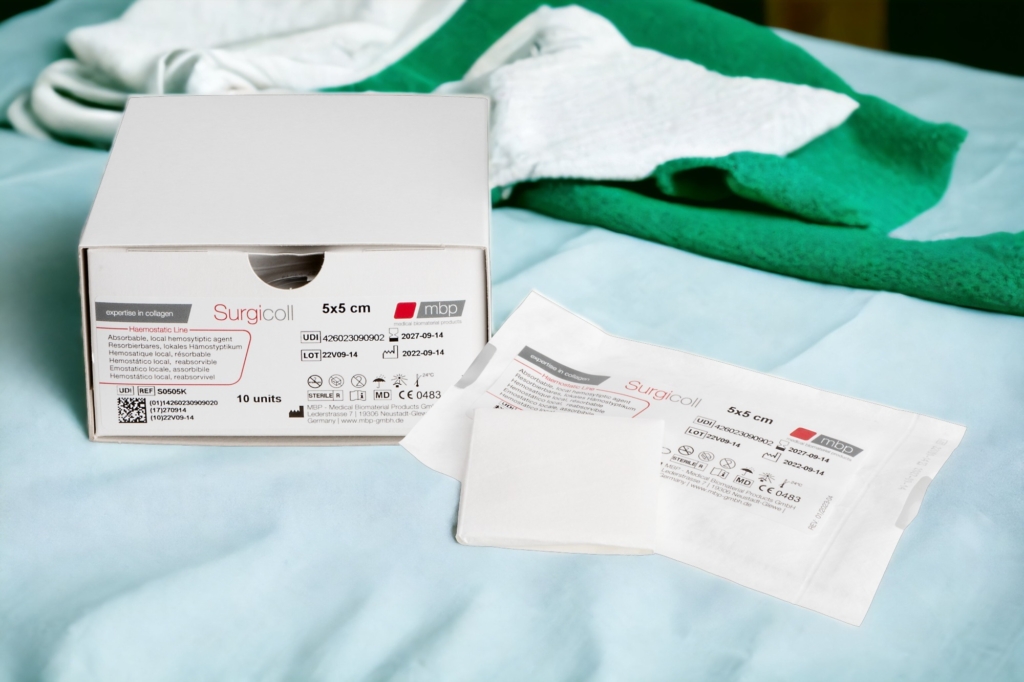
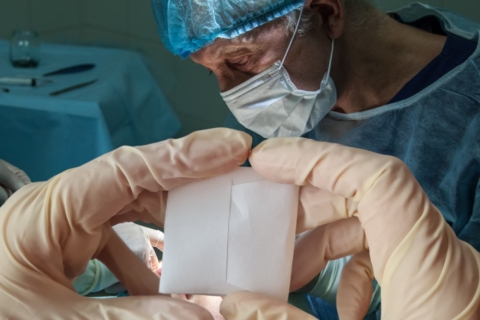
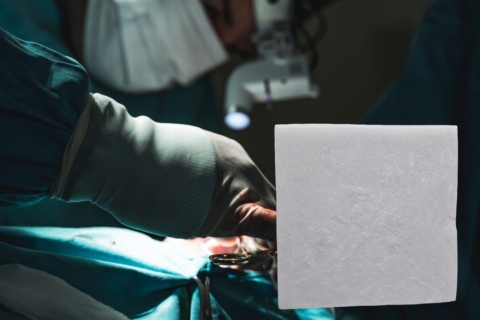
Surgicoll
Resorbable, highly effective collagen-based haemostat
Surgicoll is a fully absorbable, spongy collagen matrix for effective local haemostasis. The excellent haemostyptic effect of collagen is well known and described in numerous publications.
The spongy collagen scaffold ensures rapid and reliable blood clotting via two complementary mechanisms. While the swelling properties of the collagen scaffold lead to the concentration of platelets and thus to accelerated clot formation, the chemical and topological properties of the collagen fibrils trigger the release of blood clotting factors with the aggregation of platelets, which activate the coagulation cascade.
Properties
- Highly efficient for local haemostasis
- Promotes wound healing
- Fully absorbable within 1-2 weeks
- Easy and simple handling
Practical application description
After opening the sterile packaging, the product is removed with sterile, dry instruments and placed on the wound with suitable tools and lightly pressed on. The product can be cut to the desired size with sterile scissors. It adheres immediately to the moist wound surface and forms a gel-like bond with the blood. Excess collagen material should be removed. For external wounds, an additional overlay of e.g. non-woven fabric fixed by elastic bandages is recommended.
Intended use
Absorbable, local haemostyptic, sterile, for single use. Use is indicated wherever capillary, venous, small arterial and diffuse oozing haemorrhages need to be stopped and where conventional methods of haemostasis are either inadequate or technically difficult and time consuming. The product resorbs completely and does not need to be removed.
Areas of application: General surgery, cardiothoracic and vascular surgery, neurosurgery, maxillofacial surgery and general stomatology, oto-rhino-laryngology, urology and gynaecology.
- Medical device class III (Regulation (EU) 2017/745)
- Source of collagen: porcin
- Easy handling
- Double-sterile packaging for hygienic insertion into the operating area
- Perfect dimensions of the packaging for the operating theatre
- Easy storage at ≤ 24°C
- Has excellent biocompatibility
- Manufactured in Germany
Article number (REF) / size / sales unit/ UDI-DI
- S0101K/ 1*1 cm / 10*3 per unit/ 426023090901
- S0505K / 5*5 cm / 10 per unit / 426023090902
- S0510K/ 5*10 cm / 5 per unit / 426023090903
- S1010K/ 10*10 cm/ 5 per unit/ 426023090904
- The product is also available under the trade name Hemocol.
- H0101K/ 1*1 cm/ 10*3 per Unit/ 426023090905
- H0505K/ 5*5 cm/ 10 per Unit/ 426023090906
- H0510K/5*10 cm/ 5 per Unit/ 426023090907
- H1010K/10*10 cm/ 5 per Unit/ 426023090908
- For Hemocol orders, please contact us by phone or email.

